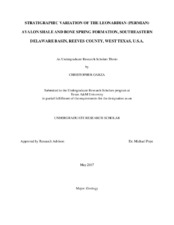| dc.description.abstract | Stratigraphic thickness may vary as a member is deposited basinward of the shelf margin. Leonardian (Lower Permian) Avalon Shale and Bone Spring Formation strata of the southeastern region of the Delaware Basin in Reeves County, West Texas provide an example of these stratigraphic thickness variations. Wireline log data of the Avalon Shale and Bone Spring Formation records a mixed carbonate and siliciclastic slope-basinal system. Units of the Avalon Shale were deposited primarily by sediment gravity flows. Members of the Bone Spring Formation were deposited by reciprocal sedimentation caused by relative sea level change. Transgressions and relative sea level highstands deposited carbonate, whereas regressions and relative sea level lowstands deposited siliciclastic rocks. Carbonate sediment gravity flows and suspension settling of sandstone and shale channelized deposition contribute to the development of Avalon Shale and Bone Spring Formation basin strata. This research investigates the change in stratigraphic thickness of the Avalon Shale and Bone Spring Formation from the southeastern to the central region of the Delaware Basin throughout Reeves County in a regional context, utilizing well log data. 26 well logs were analyzed and correlated for this study. Correlations show Avalon Shale and Bone Spring Formation units (in stratigraphically descending order); First BS (Bone Spring) Carbonate, Avalon Shale (within the First BS Carbonate; Leonard Shale (also known as “Upper Avalon” in previous studies), Middle Avalon, and Lower Avalon Shales), First BS Sandstone, Second BS Carbonate, Second BS Sandstone, Third BS Carbonate, and Third BS Sandstone have various thinning and thickening stratigraphic thickness trends from west to east, and from northwest to southeast, throughout the southeastern region of the basin. Future work on the Avalon Shale and Bone Spring Formation in the southeastern Delaware Basin can further integrate core, seismic, and petrographic data to better understand the Avalon Shale and Bone Spring Formation’s depositional processes and patterns that affected variations of thickness throughout the southeastern to central region of the basin. | en |


